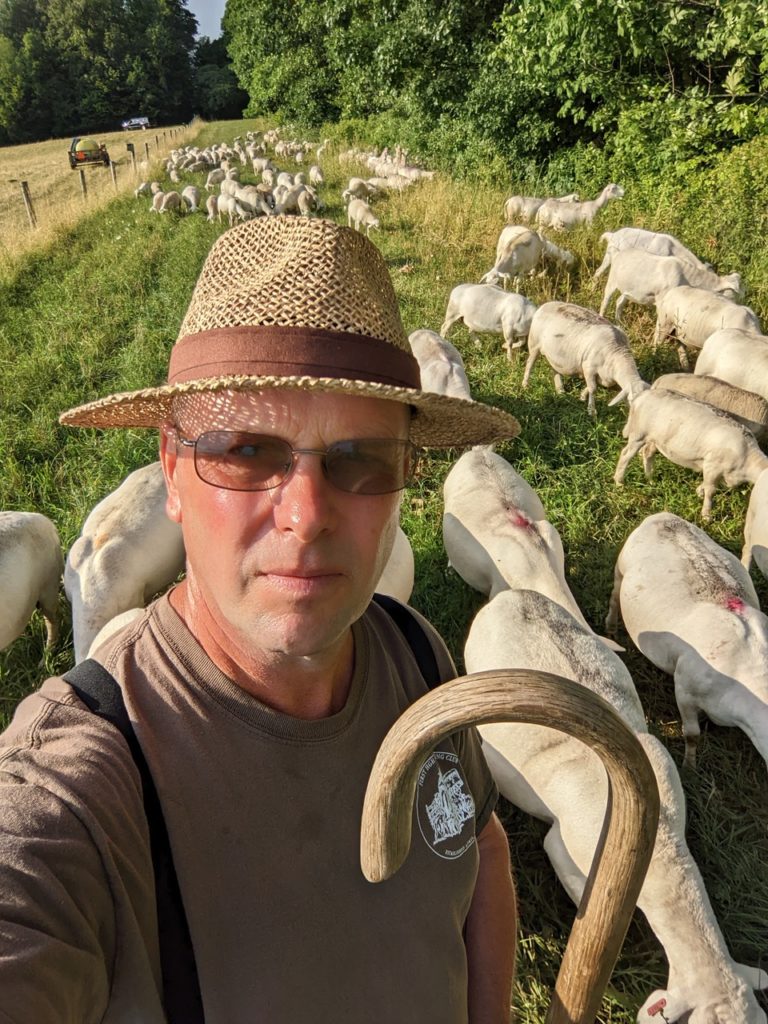Raising Sheep on all Grass
Ulf Kintzel will be a keynote speaker at the Seventh Organic Farming Conference at The Event Center in Mt. Hope, Ohio on November 10 & 11, 2022.
By Organic Farming Conference Committee

Ulf Kintzel and his flock of White Dorper sheep in the upstate New York. Image Provided
Ulf Kintzel owns and operates White Clover Sheep Farm and breeds and raises grass-fed White Dorper sheep without any grain feeding and offers breeding stock suitable for grazing. He is a native of the former Communist East Germany and has been shepherding in the U.S. since 1995. He and his family live in the Finger Lakes area in upstate New York.
Ulf will be a keynote speaker at the Seventh Organic Farming Conference at The Event Center in Mt. Hope, Ohio on November 10 & 11, 2022.
After visiting a sheep farm as a youngster, Ulf decided he wanted to become a shepherd. He spent school vacations working on that farm, and eventually did an apprenticeship in Germany to become a shepherd. “There was something appealing to me about sheep,” said Kintzel. “I was never intrigued the same way by cattle, goats, or other livestock.”
For many people there’s nothing quite as idyllic as a flock of sheep peacefully grazing on a pleasant spring day. Long esteemed as valuable livestock, sheep are gentle animals that are well suited for many types of farms and homesteads. But they also present unique challenges.
If you’re considering raising sheep on your property, there are a few things to take into account beforehand, and the first is: not all sheep are the same. And second: will your farm work as a grass farm supporting a flock of sheep as you learn the art and skills of a shepherd?
Farmers getting started with sheep often wonder about what is a good pasture for sheep. Frequently they are either putting sheep on land that has not been grazed in some time and needs to be “renovated,” or they are putting sheep on land that had been used for dairy or beef. So, many questions come up about what do sheep need and want in a pasture.
Ulf has the knowledge and experience to help you learn about grass and sheep. He said, “In a sheep farming operation that relies on grazing alone without feeding any grain, the pasture is of utmost importance. If the demand is such that the lambs should be finished in a time as short as possible, the pressure is high. I am in that situation. I finish my lambs between 3 and 6 months with the average being 4 to 5 months. The target weight is 80 to 90 lbs. live weight or 40 to 45 lbs. hanging weight. That requires that the lambs are getting pushed almost every day to eat as much as possible.”
“Several factors such as climate, soil, and amount of input (fertilizer) influence what kind of grasses and legumes should be selected. Here in upstate New York, I use only cool-season grass species. I have mainly Honeoye silt loam soil. Additionally, I have some Lansing silt loam and some Lima silt loam soil. These soils are all limestone derived, which means the need to lime is limited. I will consider some applications of lime in the future in certain areas of my farm but have not yet felt the need to do so. The only input I have chosen so far is hay that I am buying, which I feed mainly in the pasture during the winter. I do not buy any commercial or any other fertilizer.”
Ulf raises White Dorper sheep, which is a hair sheep. “The primary reason I got into this breed is because they shed,” he said, referring to his start with White Dorpers. “Wool doesn’t fetch any money and wool sheep still have to be shorn, which becomes a cost and not a profit, especially in a region where there are few sheep shearers. Hair sheep became a hot item for many people who want to raise a few sheep or a large flock, so the expense of shearing is eliminated.”
In addition to selling breeding stock, Kintzel markets lambs to buyers throughout the Northeast. “There’s a substantial group of people nowadays who seek the connection to a farmer,” he said. “They’re willing to pay a little more to get it from a source they know.” Lambs are marketed at about 80+ pounds but under 100 pounds. “That’s the ideal carcass,” said Kintzel. “It’s the right ratio of meat, fat and bones. Traditional American lamb is larger when it’s harvested and getting to that weight takes more time and effort.”
Kintzel’s keynote on Friday morning, the 11th, will be “A Shepherd’s Journey from East Germany to New York.” In the afternoon he will have a breakout session “Managing Pasture Quality for 100% Grass Production of Sheep.” These same management practices apply to dairy graziers as well as sheep.
Ulf is a long-time contributor to Farming Magazine, where he writes on sheep.
Mark your calendar for November 10 & 11 and come listen to Ulf Kintzel at Mt. Hope, Ohio as he shares the story of his success in all-grass sheep production on their 100-acre farm in Rushville, New York using natural methods in work, life, and play wherever possible.
Registration for the two-day event is $25 per person per day or $35 per person for both days. They are still accepting vendors as well. Call 330.674.1892 for more info or visit and register online at: www.organicfarmingconf.com or write to: OFC, P.O. Box 214, Millersburg, OH 44654.

